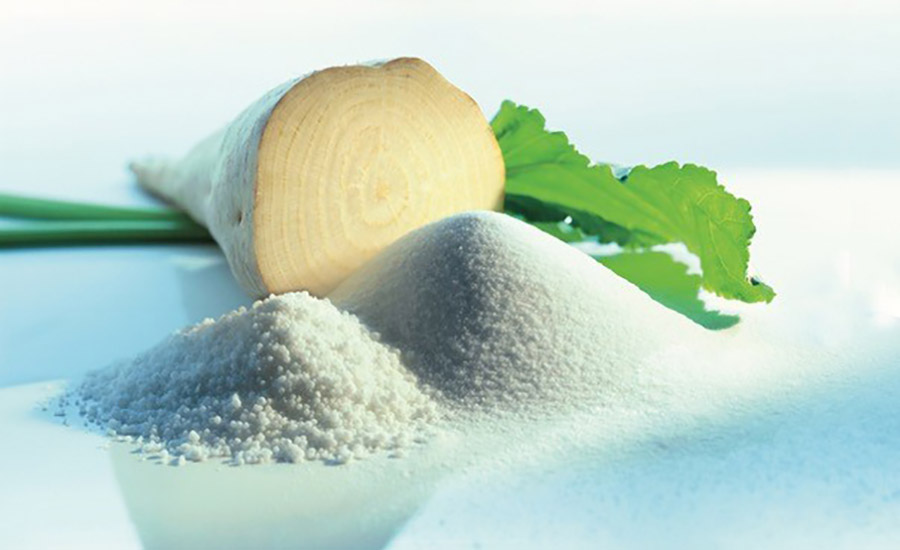The sugar reduction trend is here to stay
Consumers are continuing to seek healthier options, with many taking aim at sugar.

Photo courtesy of panida wijitpanya / iStock / Getty Images Plus
“No sugar tonight in my coffee. No sugar tonight in my tea. No sugar to stand beside me. No sugar to run with me.”
The Guess Who were clearly singing about emptiness or loneliness during its 1970 song and not talking about sugar literally. However, an increasing number of consumers more than 50 years later are saying “no” to sugar in their coffee, tea and many dairy products.
Sugar substitutes are certainly nothing new. In fact, Splenda is currently celebrating its 25th anniversary with its “25 Years of Sweetness” campaign, including special packaging, a yearlong event tour throughout the United States, as well as partnering with Princess Cruises for a mid-summer sweepstakes to give away three cruises. Splenda is also committing $2,500 to 25 families affected by diabetes to offset the cost of treatment and medical supplies.
Perhaps, this effort will further enhance the sweeteners market, which continues to grow. According to Markets and Markets, the sweeteners market is projected to reach $144.7 billion by 2028, compared to $115.8 billion in 2023, growing at a compound annual growth rate of 4.6% from 2023 to 2028.
However, this does not mean the zero- and reduced-sugar trend cannot be disrupted. Many remember the low-carbohydrate trend, low-fat trend and Atkins diet trends for example. In sum, consumers are a finicky group and can change their mind on a dime.
Is the reduced sugar trend here to stay?
“Consumer interest in reduced-sugar products has been climbing steadily for the last decade and shows no sign of waning. However, consumers aren’t willing to compromise,” responds Mark Fahlin, business development manager for dairy, Cargill, Wayzata, Minn. “They expect these products to deliver similar indulgent experiences as their full-sugar counterparts. Fortunately, advances in ingredient solutions and formulation science are making this possible, closing lingering gaps around taste and mouthfeel to deliver reduced-sugar products that still live up to consumers’ sensory expectations.”
“Sugar reduction, no-sugar-added and zero sugar is going to continue,” continues An Ho, director of food science and product innovation, IFPC, Fenton, Mo. “Sweeteners continue to improve; sweetener types continue to become approved by the FDA, and most importantly, the combination of these sweeteners can provide a very similar flavor profile to real sugar.”
Thom King, CEO and chief food scientist at Icon Foods, Portland, Ore., stresses sugar reduction is not just a consumer trend. “Zero- and reduced-sugar products are here to stay because consumer awareness of how sugar impacts health and how much sugar is in products is increasing,” he says. “Demand will only grow when the FDA’s front-of pack guidelines (TRUTH in Labeling Act) for added sugar are implemented. …I think you’ll see a huge shift in people moving away from high-sugar products as their awareness increases.”

According to Ravi Arora, sales and marketing director, Global Organics, per-capita sugar consumption in the U.S. continues to decline year on year since its peak in 1999. “Despite this fact, Americans still consume more than 10 times the lowest recommended intake of 11g daily,” Arora says.
However, Linnea Halter, marketing coordinator, Global Organics, clarifies that is it perhaps improper to say “zero sugar” is here to stay because sugar isn’t going anywhere, especially when being used in products for a more desirable taste. “Even products with labels claiming to have zero sugar normally have some amount of natural sugars that come from ingredients like fruit juice concentrates. That being said, the trend of reduced sugar is increasingly rising and we believe it will only continue to grow. The focus on reduced-sugar ingredients in products is certainly warranted and reflects a growing demand from health-conscious consumers,” Halter states.
Problems with sugar
As just mentioned, even with a boom of reduced-sugar products, sugar itself is not going anywhere. How bad is the ingredient for consumers?
“Cargill proprietary research finds sugar tops the list of ingredients consumers wish to avoid, ahead of sodium, fats and artificial ingredients. When it comes to on-pack information, our research finds consumers are more likely to check the amount of sugar versus look for a specific sweetener or claim,” states Fahlin.
These findings are backed up by data from the International Food Information Council, which reveals that 72% of Americans aim to limit or avoid sugar, he adds. “In fact, consumers rank sugar reduction as the top way to make processed foods and beverages healthier, outranking things like eating clean, removing other negatives (like sodium) or adding positives (like protein and fiber) (HealthFocus International-USA report, 2022).”
Issues arise when high amounts of added sugar are consumed, notes Joe O’Neill, vice president, sales and business development, for A&B Ingredients, Fairfield, N.J. “Added sugars, often found in processed foods and sugary beverages to enhance the sensory profile, contribute extra calories without providing essential nutrients. Excessive consumption of added sugars has been linked to health issues such as obesity, type 2 diabetes, and cardiovascular disease,” he reveals.
Hannah Dressen, business development manager – Batory Sweetener Solutions, Rosemont, Ill., looks at it similarly. “The incidence of Type 2 Diabetes, obesity, and heart disease are ongoing and well-defined problems associated with consuming too much sugar in one’s diet,” Dressen states. “This is why it’s important for us in the food industry to be proactive in supporting consumers in ways that will help them to manage these issues.”
Kyle Krause, BENEO regional product manager, Functional Fibers and Carbohydrates, North America, Parsippany, N.J., stresses the responsibility lies on manufacturers to offer foods and drinks to help control weight. “And the most promising way to stick to a better-for-you diet long-term is if there’s not that much sacrifice involved. That is our starting point as a company,” he notes.

Chicago-based ADM offers new proprietary research on the topic, which it shared with Dairy Foods. It shows that 57% of U.S. adults surveyed claim they are taking specific actions to manage their blood sugar, with 40% monitoring their blood glucose levels outside of routine doctor visits using at-home devices.
“As consumers seek ways to manage their blood glucose levels and reach wellness goals, our research finds that 44% of U.S. consumers surveyed believe diet and nutrition are the most important variables,” states Sarah Diedrich, senior marketing director, Global Sweetening & Texturizing Solutions, ADM. “One of the first ingredients to be looked at is sugar, with 84% of consumers claiming they are actively avoiding or limiting sugar in their diets. These shoppers want products with low sugar, and they are examining all product purchases for sugar content, including ice cream and frozen treats, yogurts, protein shakes, alternative dairy beverages, and more. Our new research also finds that 70% of consumers are looking to add more low-sugar products to their diet, with 37% claiming they are trying to add more sugar alternatives.”
Which Ingredients Work?
Based upon the prior commentary, it is clear there is plenty of consumer demand for zero- or reduced-sugar products. But what ingredients are excellent sugar replacements? “After all, consumers are seeking healthier diets, but 88% of consumers still say that taste has the greatest impact on their food and beverage purchases,” reveal Papao Saisnith, senior director, Global Marketing & Innovation, Sugar & Calorie Reduction, and Alvaro Velasco, category strategy manager, dairy, for London, UK-based Tate & Lyle.
“Dairy manufacturers must strike a fine balance between reducing sugar content without losing the taste and texture qualities that consumers love,” they tell Dairy Foods. “The overall taste experience in dairy is complex and there are many sensory and technical aspects that need to be considered, such as sweetness quality, texture dimension, bulking impact, and mouthfeel experience.”
Stevia solutions is a great way to address sugar reduction and meet consumers’ expectations in the ‘natural’/non-artificial space, the Tate & Lyle executives add. “Stevia is extremely versatile and easy to use in dairy applications. It is often used in reduced sugar ice cream, high-protein drinks, and yogurt products. There is also an increasingly positive attitude from consumers toward stevia. More than half of consumers in North America perceive juice products containing stevia as healthy, natural, and tasty, with nearly 50% calling them ‘exciting.’”
For a dairy-based product with plenty of free water, Reb M has a pleasant taste, Ho adds. “The solubility is a bit tricky. This can be offset with a combination of other sweeteners that have strong solubility,” she says. “Allulose and Erythritol are great in combination with high intensity sweeteners in dairy. They are clean-tasting bulking agents to maintain proper freezing points and build-back mouthfeel. Allulose also has browning capabilities.
“Monkfruit is a very label-friendly sweetener and complements various stevia extracts,” she adds. “It has a slight fruity note, so when paired with fruit-based applications, it is great.”
Natural flavors are great to use in dairy products for sugar reduction, Halter relays, noting using natural and organic flavors, such as vanilla, cocoa, coconut nectar, agave and fruit concentrates can enhance the taste of dairy products without adding sugar. “These flavors can help mask any potential aftertaste and provide a more enjoyable sensory experience. Regarding the ease of manufacturing ingredients for certain dairy products, it depends on the specific product and the desired sugar reduction level. Some dairy products may be easier to reformulate than others due to factors such as the presence of other ingredients, processing methods and the desired texture,” Halter says.
Look no further than chicory fiber as a sugar-replacement for many dairy products, O’Neill stresses. It offers numerous nutritional and functional advantages and stands out as a healthy solution for sugar reduction in dairy and non-dairy products, he says.
“Chicory fiber (inulin) is a clean-tasting fiber that helps maintain sweetness in reduced-sugar applications without contributing to the added sugar declaration,” he notes. “Chicory fiber also has fat-mimetic properties, which help improve mouthfeel and creaminess in dairy and non-dairy products.”

In cultured and beverage dairy applications, chicory fiber can replace sugar, including sugar in fruit preparations, and complement high-intensity sweeteners, helping mask the off-flavors. In fresh cheese application, chicory root fiber can reduce fat (up to 30%) without affecting the texture and retaining the creamy feel of the cheese in the mouth, O’Neill continues. And another “rising trend” is using chicory fiber in frozen desserts and ice cream.
“Consumers can satisfy their sweet cravings without guilt, as chicory prebiotic fiber can help reduce sugar and fat and lower calorie content in frozen desserts, catering to the low-carb and keto markets,” O’Neill maintains.
A gut punch?
Beyond taste, a huge factor when manufacturing sugar alternatives is taking gut tolerability into account. If an ingredient does not “agree” with a consumer, it certainly reduces its viability as a sugar replacement.
Arora reveals that new research continues to shine light on the effects of alternative sweeteners on glucose intolerance, the activation of the sweet receptors, as well as the alterations to the composition of intestinal microbiota. “Formulators need to be aware of these studies when selecting alternative sweeteners,” the Global Organics executives says.
Dressen adds that balancing digestive tolerance is critical for dairy products, especially as it comes to introducing consumers to different alternative sweeteners. “It is important to work with suppliers to understand any GI (gastrointestinal) research behind your ingredient as well as consulting GRN limitations for usage quantities in the respective dairy categories when formulating,” Dressen states.
Ho notes that Inulin and sugar alcohols cause stomach discomfort for people, in general. “So, too much (even though ‘healthy’), is not worth the discomfort. But high intensity sweeteners do not affect the gut due to the very small amount needed to produce a sweet taste,” she states. “The discrepancy is if they are OK to be on the label or if people are used to the off-notes that can be associated with them like metallic, bitter, lingering, licorice, chemical tastes.”
“One of my favorite sweeteners is allulose because of its functional properties, neutral taste, and because it doesn’t cause any GI distress,” responds King. “Overusing single fibers and polyols can trigger GI issues, but if you use those ingredients in tandem with each other, such as an inulin-type fiber with a resistant dextrin fiber, it solves the issue by avoiding monoculturing, so you can achieve a higher fiber count, along with the bulking benefits and contributing sweetness. And, of course, don’t load up with one bulking sweetener, like erythritol or xylitol. More than 12g can lead to higher water activity in the lower intestine.”
Krause asserts there is no “magic pill” for sugar reduction. “With regards to BENEO’s ingredients, its chicory root fibers inulin and oligofructose are well-tolerated in normal use levels within dairy and other food and beverage products to provide nutritional and technical benefits. Orafti Inulin and Oligofructose also improve a more balanced intestinal flora by stimulating the growth of beneficial bifidobacteria, an important element of good digestive health backed up by scientific research and are identified as a proven prebiotic by the International Scientific Association for Probiotics and Prebiotics (ISAPP),” he maintains.
“Likewise, Isomalt from BENEO is well-tolerated in use levels that allow for appropriate sugar reduction, while Palatinose can replace sucrose and other sugars gram for gram, especially when blood sugar management and sustained energy structure/function claims wish to be made.
New Ingredients
In addition to the just-mentioned ingredients from BENEO, as well as its extension to its prebiotic solutions from the Orafti Organic range — an organic variant of chicory root fiber — all respondents are aiming to meet the needs of consumers seeking sugar reduction.
Tate & Lyle recently expanded its sweetener portfolio with TASTEVA SOL Stevia Sweetener. “An internationally patent-protected breakthrough in stevia technology, TASTEVA SOL is a premium tasting stevia that has over 200 times the solubility of Reb M and D products on the market,” note Saisnith and Velasco. “It solves solubility challenges often found in dairy fruit preparations and sweet syrups at high sugar reduction levels. TASTEVA SOL can be used alone or in combination with Reb M stevia sweeteners for high sugar replacement and provide sugar-like taste.”
Cargill’s newest sweetener system, EverSweet + ClearFlo, brings together the company’s stevia sweetener with a natural flavor in a combination that offers wide-ranging benefits, including flavor modification and enhanced mouthfeel, improved solubility and stability in formulations, and faster dissolution, the company states.
In no-sugar-added chocolate milk, Cargill’s sensory testing found EverSweet + ClearFlo enhances the chocolate flavor profile and provides a creamier, more indulgent mouthfeel. “In yogurt fruit preparations, it delivers a sweetness profile that lets fruit flavors shine,” Addington says.
Cargill’s recently launched Gerkens Sweety cocoa powders are a “great option for 15 to 30% sugar reduction in chocolate-flavored beverages,” she continues. “Sweety cocoa powders are low in bitterness, with strong, well-balanced chocolaty flavors and a sweet perception. As a result, less sugar is needed in the final application, enabling sugar reduction without additional sweeteners or artificial ingredients.”
IFPC has launched a sweetener in sweet tea as a non-artificial alternative to full-sugar sweet tea. “It has been a hit and we have shown it in trade shows. The finished product available in grocery stores has unique flavor combinations with it, along with plain,” Ho explains. “It is going well.”
Icon Foods recently launched ThauSweet DRM, a blend of soluble tapioca fiber, thaumatin and stevia rebaudioside M. “Approximately 20 times sweeter than sugar, ThauSweet DRM utilizes soluble tapioca fiber derived from cassava root as a carrier to create a plug-and-play replacement for sugar. It is an RS4 resistant dextrose that adds bulk without grittiness, while contributing to fiber on the NFP. Thaumatin is one of the sweetest natural substances known to man, but is almost exclusively used for its flavoring characteristics; flavor and sweetening modifying effects which occur at very low inclusion levels of less than .05%.” King reveals.
Global Organics now offers an organic sweet agave inulin powder, which is a 50/50 blend of agave inulin and sweet agave powder, Halter states. “This blend has the benefit of functioning as a sweetener, while also providing a source of prebiotic fiber for products aimed to support gut wellness. Inulin powder can be added to dairy products like yogurt, ice cream or milk-based beverages as a functional ingredient. It can act as a thickening agent, providing a creamy texture to the product.”
The Cambridge, Mass.-based company also offers Organic Coconut Sugar that has a glycemic index of 35 that is significantly lower than cane sugar’s glycemic index. “The ingredient has a molassy and nutty flavor that is distinctly different, and can offer a new base for innovative products,” Arora says.
The latest additions to the A&B Ingredients prebiotic fiber portfolio include Fibruline Instant powder and Fibrulose liquid fiber,” O’Neill notes. “Fibrulose is a high-fiber liquid chicory fiber that doesn’t contain added sugars and provides 40% sweetness for easy one-to-one sugar replacement. It offers excellent binding properties and could be used for fiber fortification and sugar substitution in dairy beverages, frozen desserts, chilled fruit preparations, and plant-based dairy,” he says.

This past year, ADM expanded its stevia portfolio to include SweetRight Stevia Edge-M, which has zero calories and zero glycemic index, according to Diedrich. “It provides increased solubility, improved sweetening and reduced bitterness when compared to Rebaudioside (Reb) M. Because it is directly isolated from the stevia leaf and is not produced via bioconversion or fermentation, SweetRight Stevia Edge-M can be listed as ‘stevia leaf extract’ on product labels, supporting highly sought-after clean-label claims,” she says.
ADM also introduced its SweetRight agave in 2023, and it has a notable sweetening potency 25% to 30% higher than sucrose. “Its exceptional solubility and neutral sensory profile make it a fantastic solution for dairy beverages and plant-based frozen treats,” Diedrich suggests. “Plus, SweetRight agave ticks several boxes for consumers scrutinizing ingredient labels, as it is Fairtrade and certified organic.”
A “sweet” future?
In the future, expect the unexpected. There is little doubt consumer health habits will continue to evolve and change. The sugar reduction trend has great potential to both stay and evolve.
“Potential product innovation opportunity lies in improving the taste and eating qualities of sugar-reduced foods,” A&B Ingredients’ O’Neill expects. “Finding synergies with complementary flavors, like vanilla and others, can help offset any adverse effects or carry-over flavors when using high-intensity sweeteners.”
“Over time, our understanding of the functionality, flavor profiles, limitations and capabilities of sugar alternatives will continue to grow and should enhance our food products to meet evolving consumer demands,” says Batory’s Dressen. “It will be especially critical for brands to understand the unique profiles they are targeting and continue to refine them as consumer health habits grow and change. Enabling consumers to make better choices for their health and well-being should be a key focus for us all.”
As clean-label demands become a baseline expectation for the modern shopper, ADM anticipates a greater push toward ingredients deemed as “closer-to-nature.” “This includes sweeteners derived from natural sources in low- or no-sugar products. Consumers also consider sweeteners derived from natural sources to be ‘better’ overall — for their well-being, the environment and with better taste — and free from artificial ingredients,” Diedrich states. “Recognizable sources with high consumer affinity, like stevia and agave, will continue to capture consumers’ attentions. Dairy brands that lean into these familiar sources when formulating reduced-sugar products are likely to find success with shoppers.”
“Balancing taste, cost, and functionality (mouthfeel, browning, freezing point depression, etc.) will progress as more trials and tests are being conducted to ensure safety and shelf life,” responds IFPC’s Ho. “Developments are always being made, just like technology. Sugar is great to indulge, but it can be balanced with reduced sugar alternatives to improve health.”
Expect to see continued improvements in sugar-reduction technology, as we get closer and closer to replicating all of sugar’s taste and functionality, Cargill’s Addington predicts. “With the tools available today, we typically need multiple ingredients to replace sugar, but I can envision a future where we’ll have a true one-to-one replacement ingredient for sugar. Every advance brings us a little bit closer to this goal, and I am excited to see the continued research in this space.”
Manufacturers will need to innovate and evolve their offerings to match sugar reduction and bulking/solids replacement in one, Tate & Lyle’s Saisnith and Velasco claim. “In dairy, texture and mouthfeel play a large role in consumer preferences. Because of this, achieving a natural taste perception while maintaining desired texture attributes will be key for future innovation and driving consumer interest.”
“I believe consumers will continue to look for more sugar-reduced products in categories they continue to buy,” BENEO’s Krause maintains. “At the same time, we know that taste is paramount and that those products will only be purchased regularly if they have the same great taste and texture.”
“The reduced sugar trend is here to stay. While folks are exercising more, there continues to be overwhelming research that shows that diet matters more than exercise,” concludes Global Organics’ Arora. “Ultimately, people need to be smart about senseless consumption. There are plenty of dairy food options in the market currently that are made with reduced sugar options, and there continues to be new ingredients that offer a balance of health benefits along with sugar reduction.”
Looking for a reprint of this article?
From high-res PDFs to custom plaques, order your copy today!







